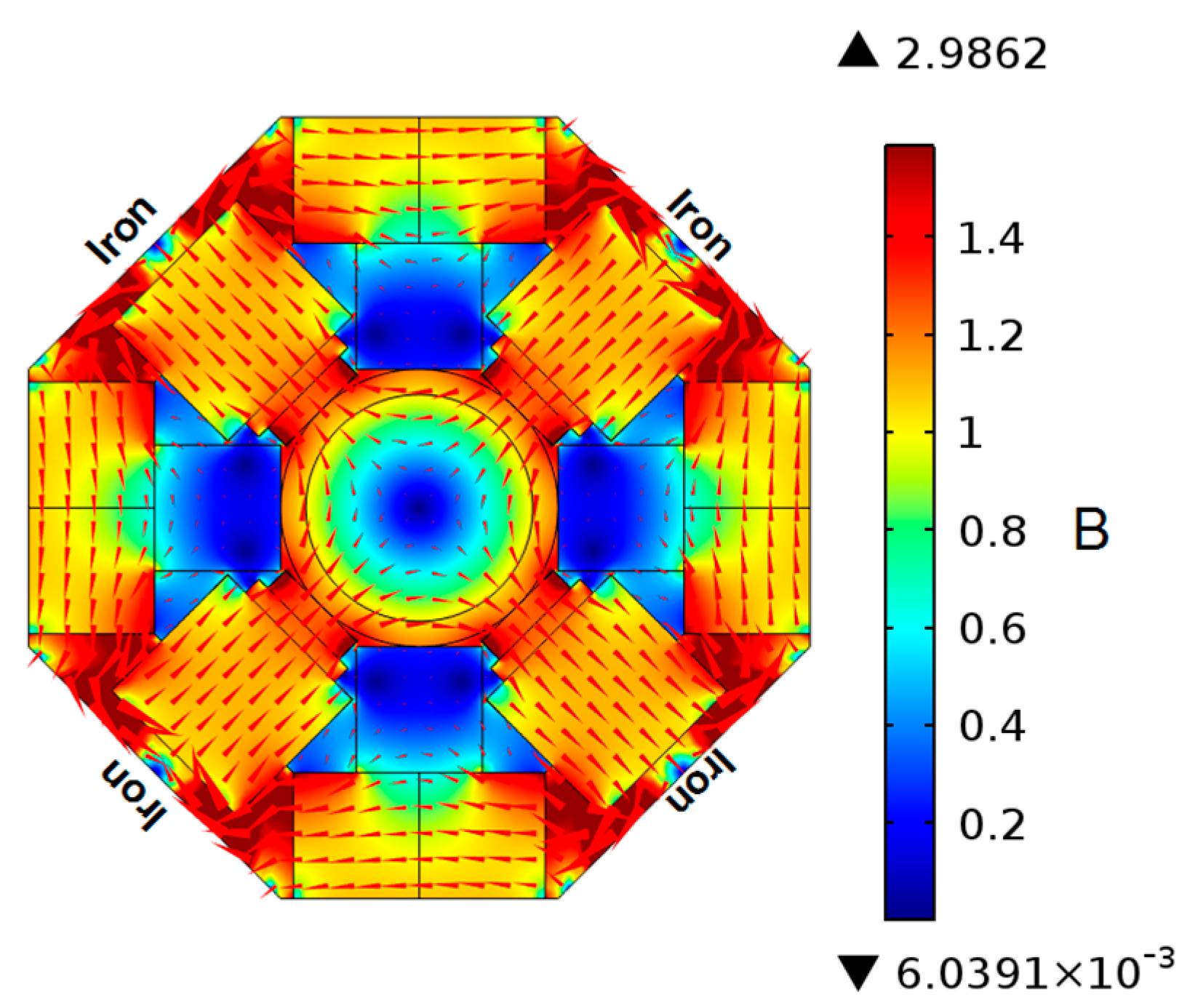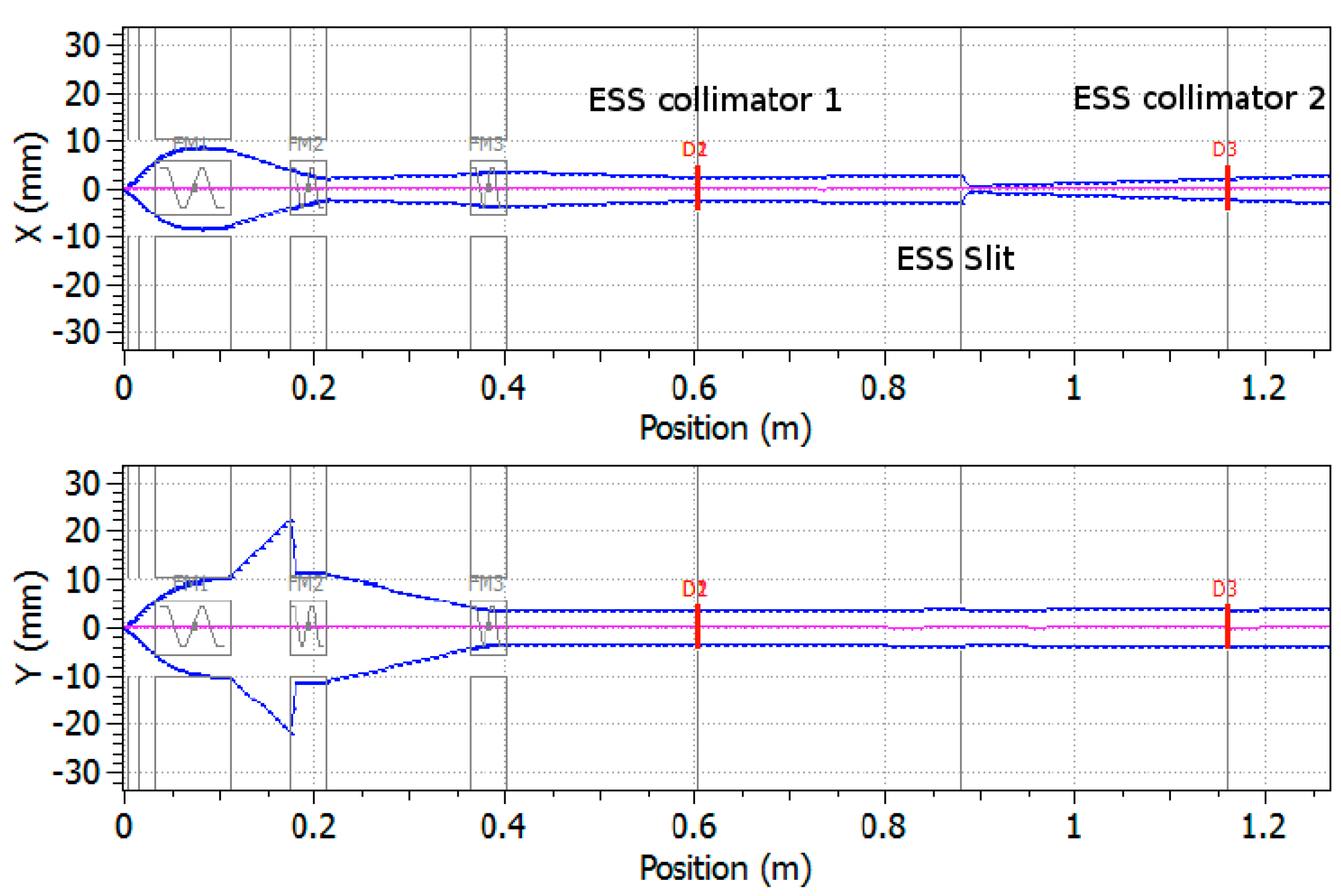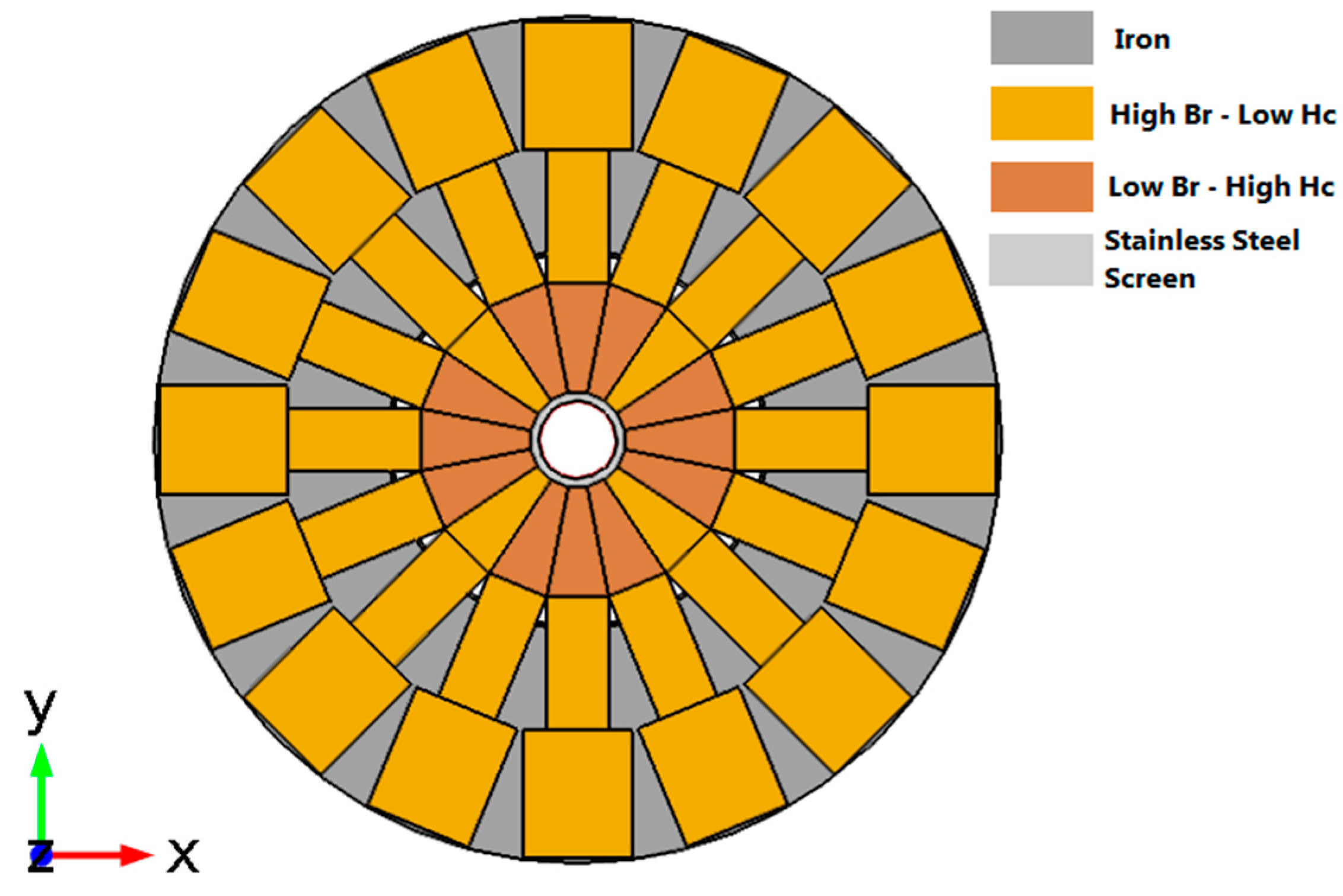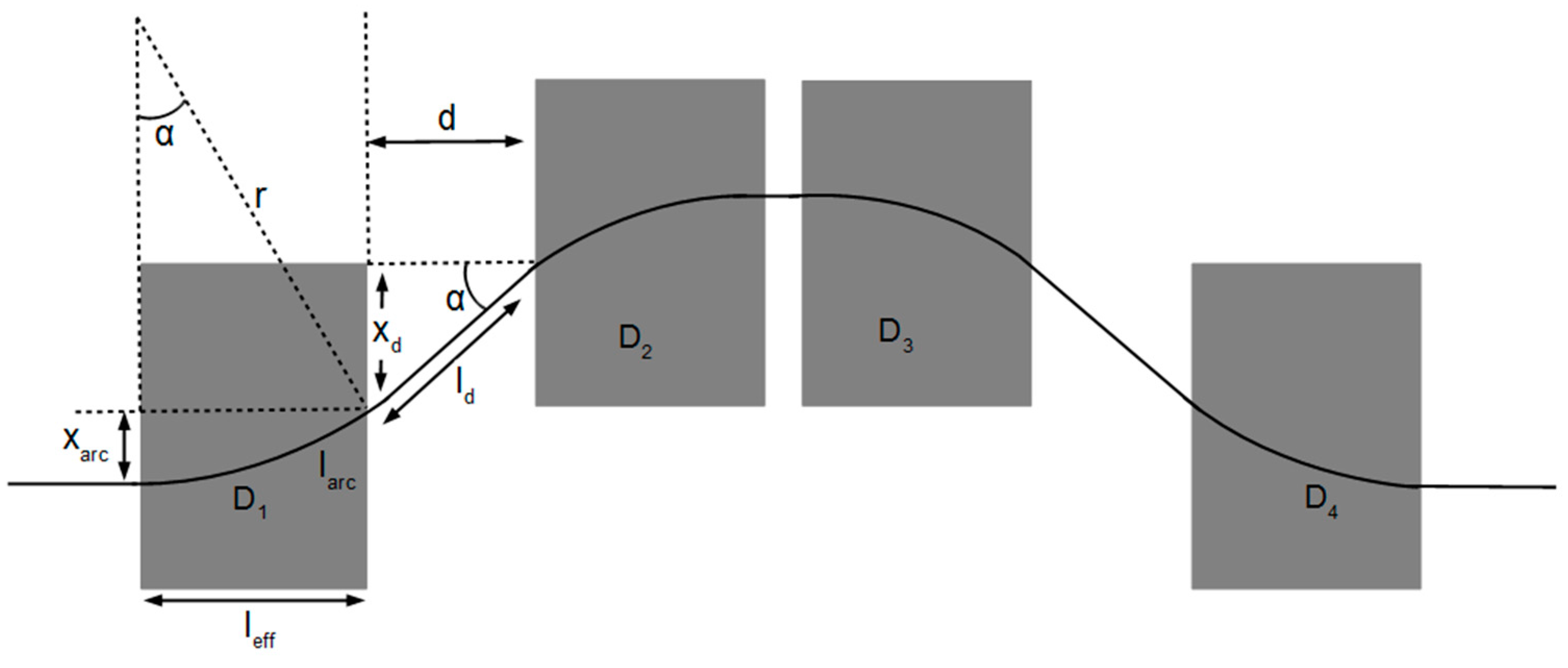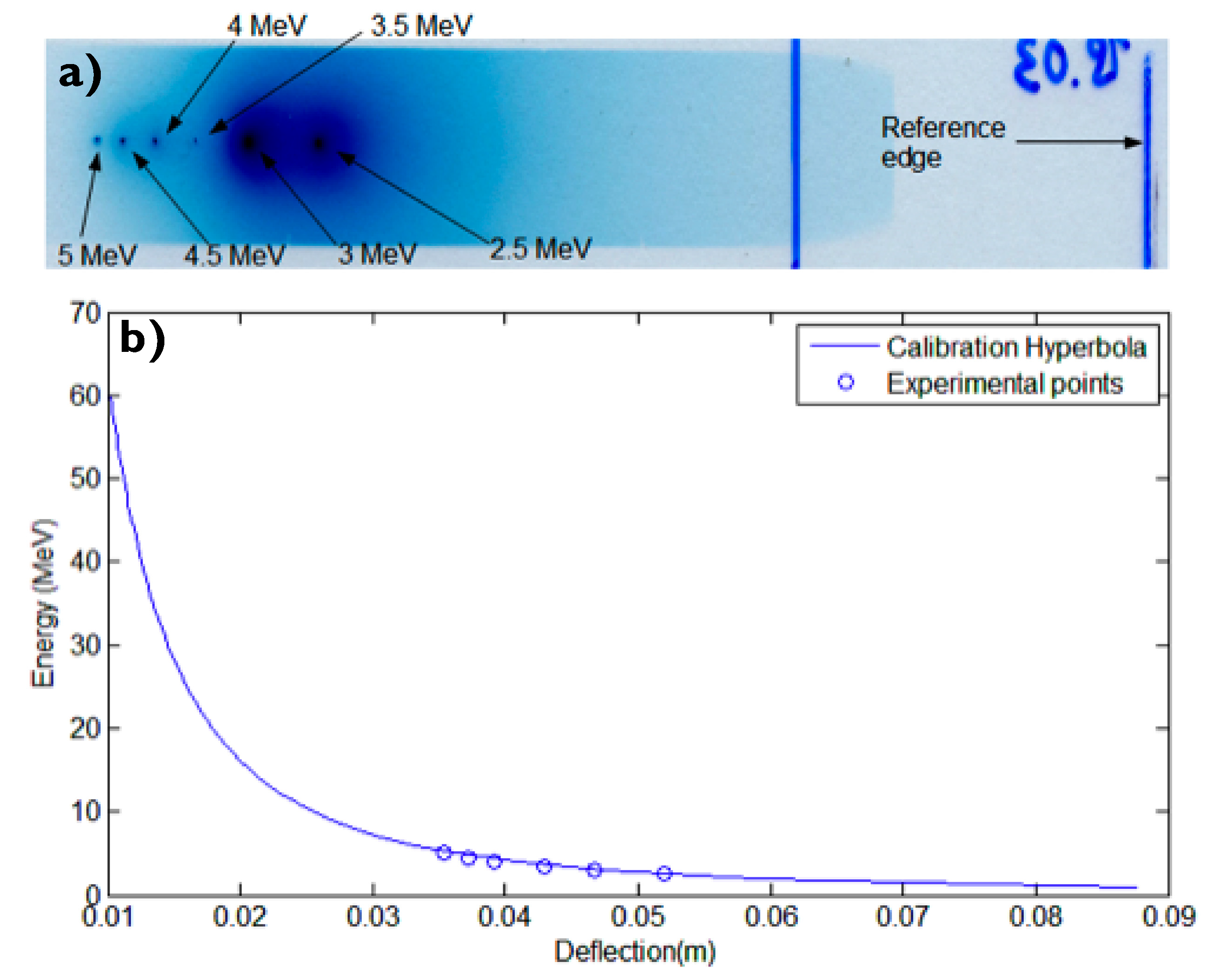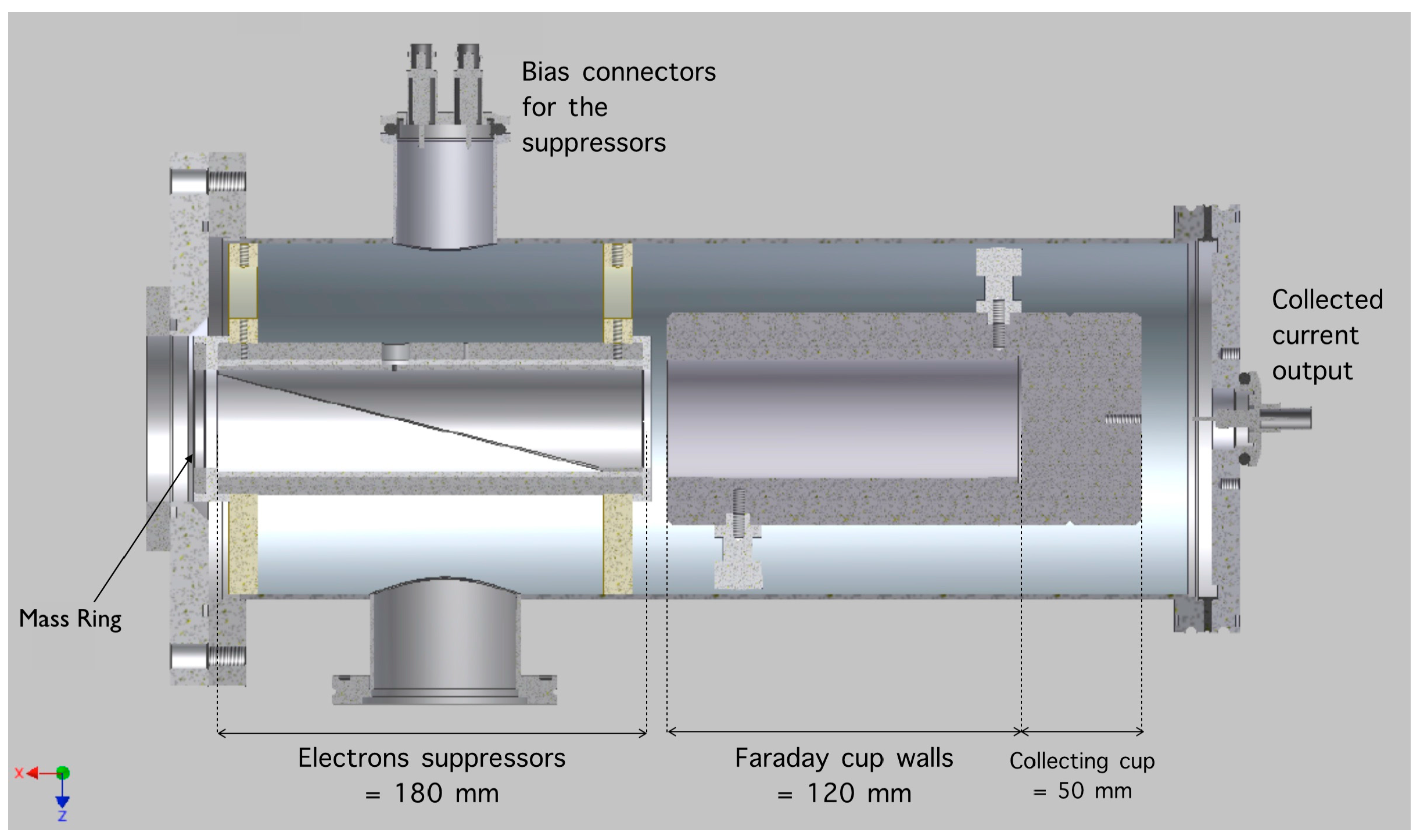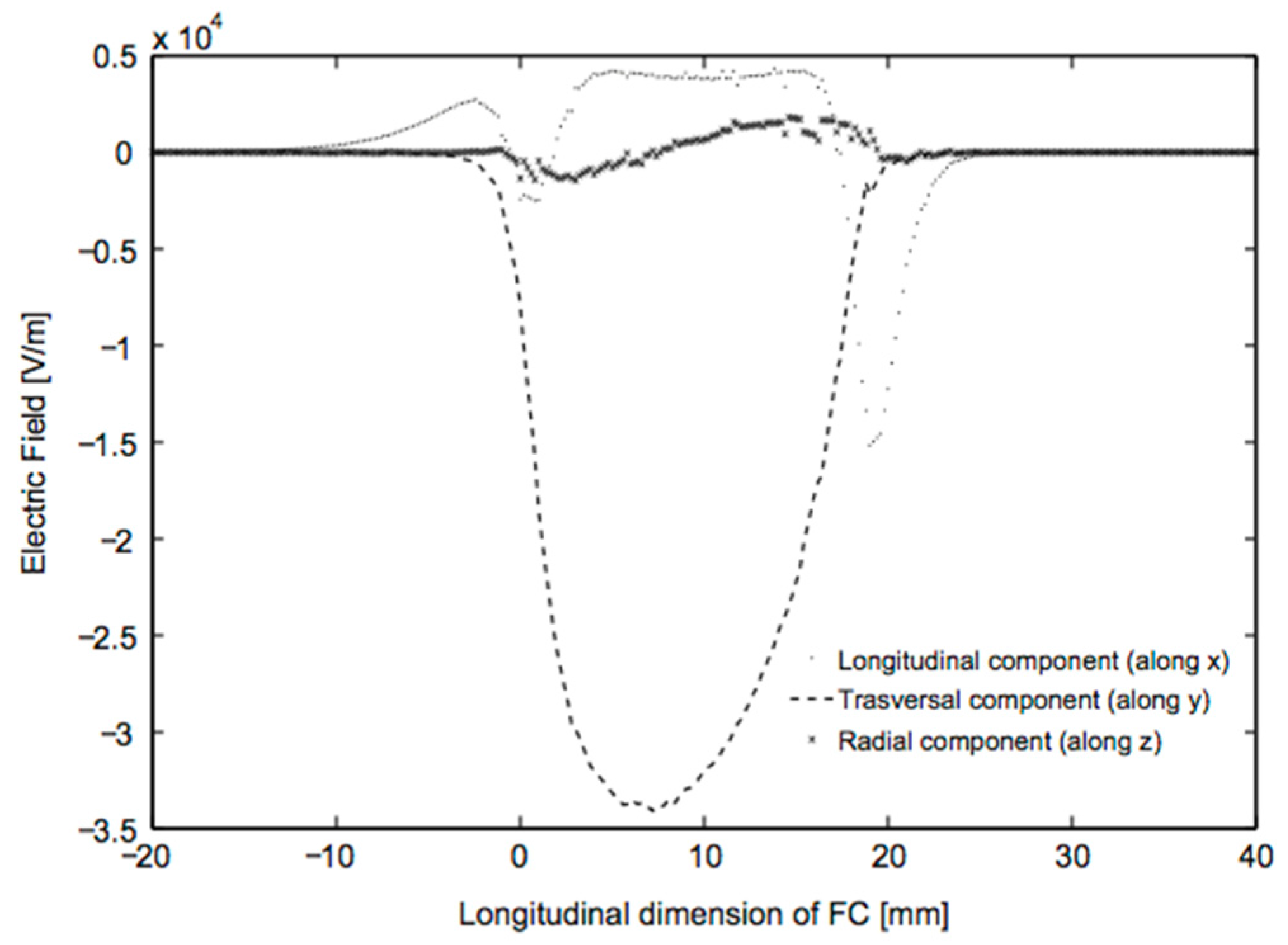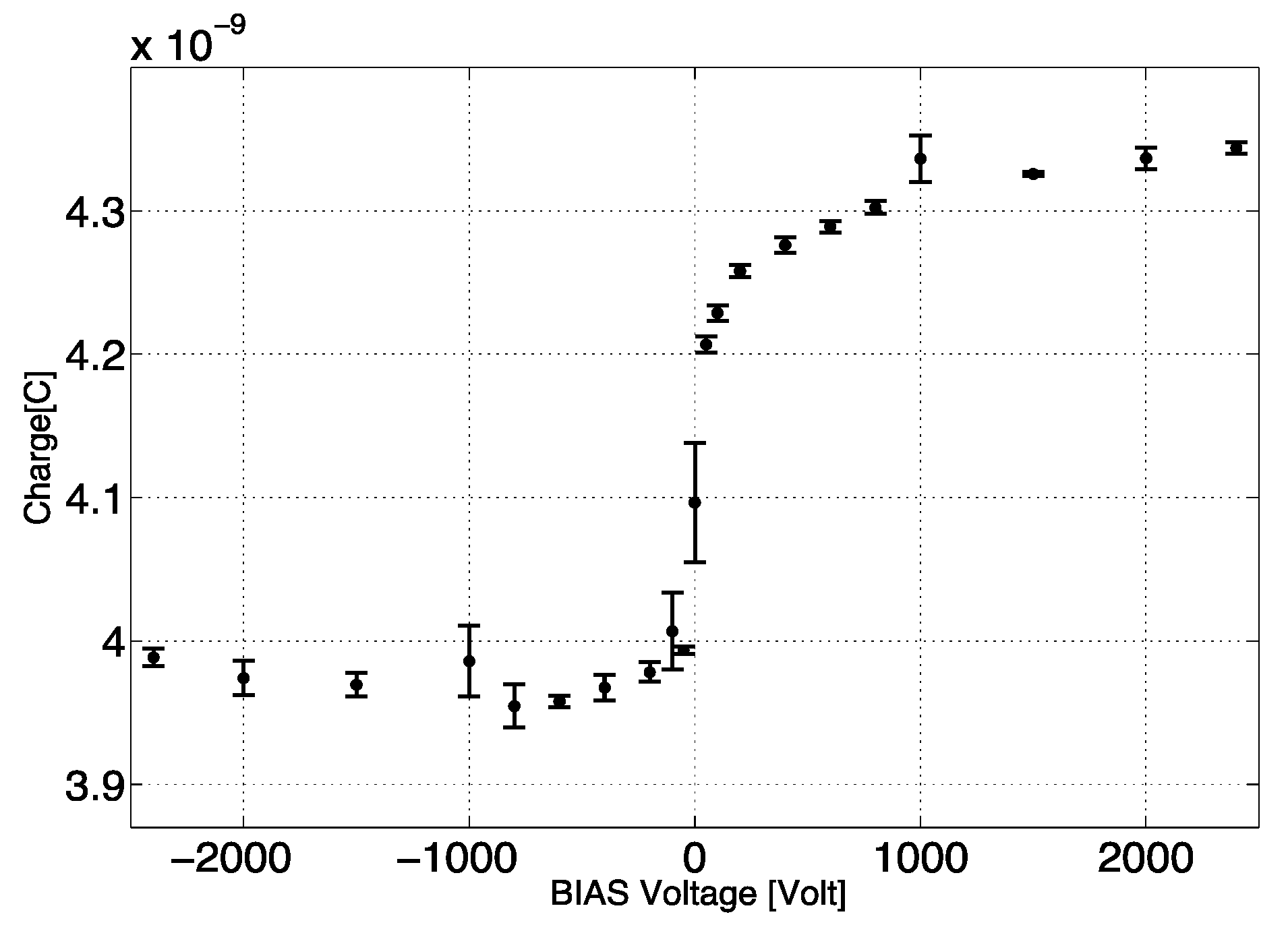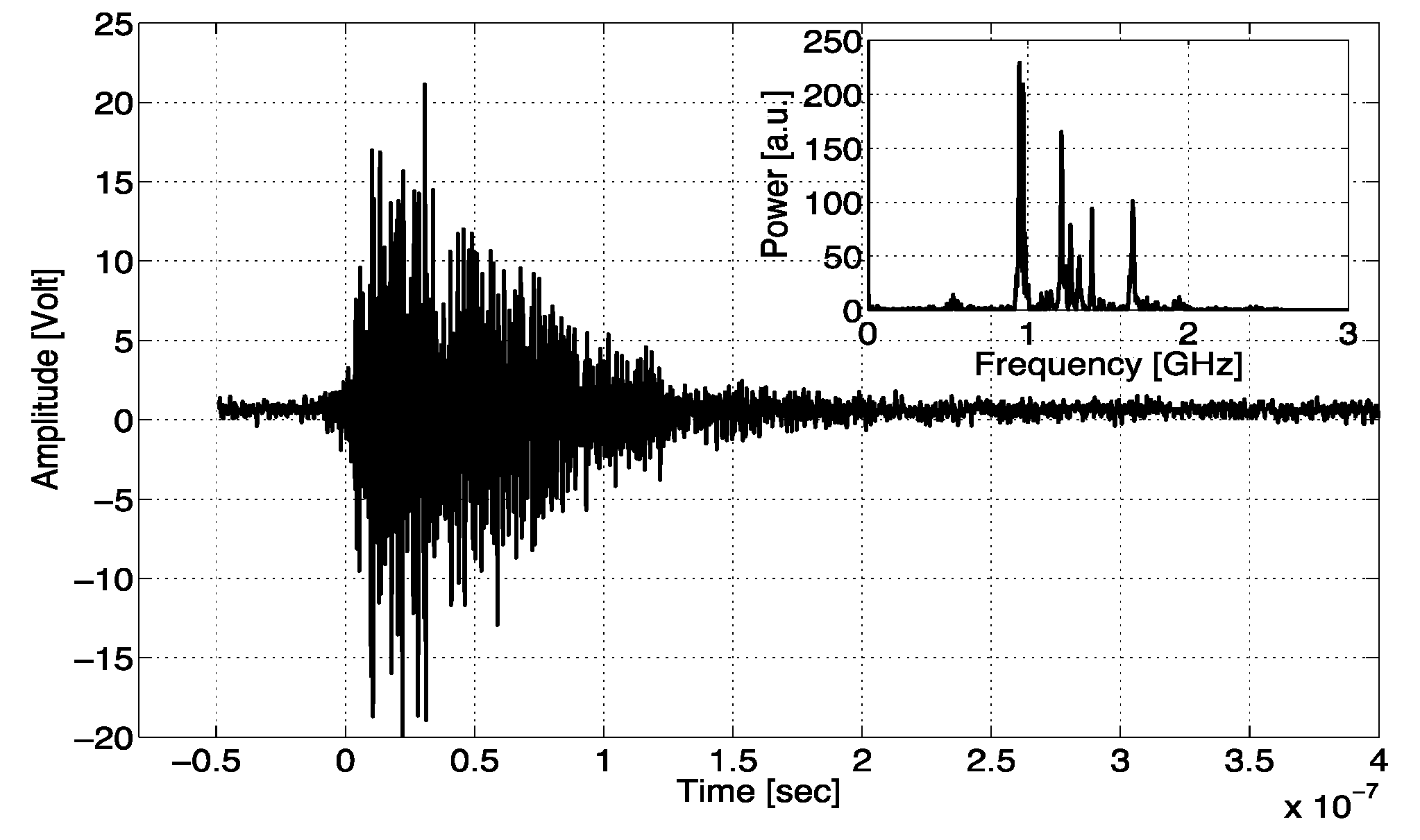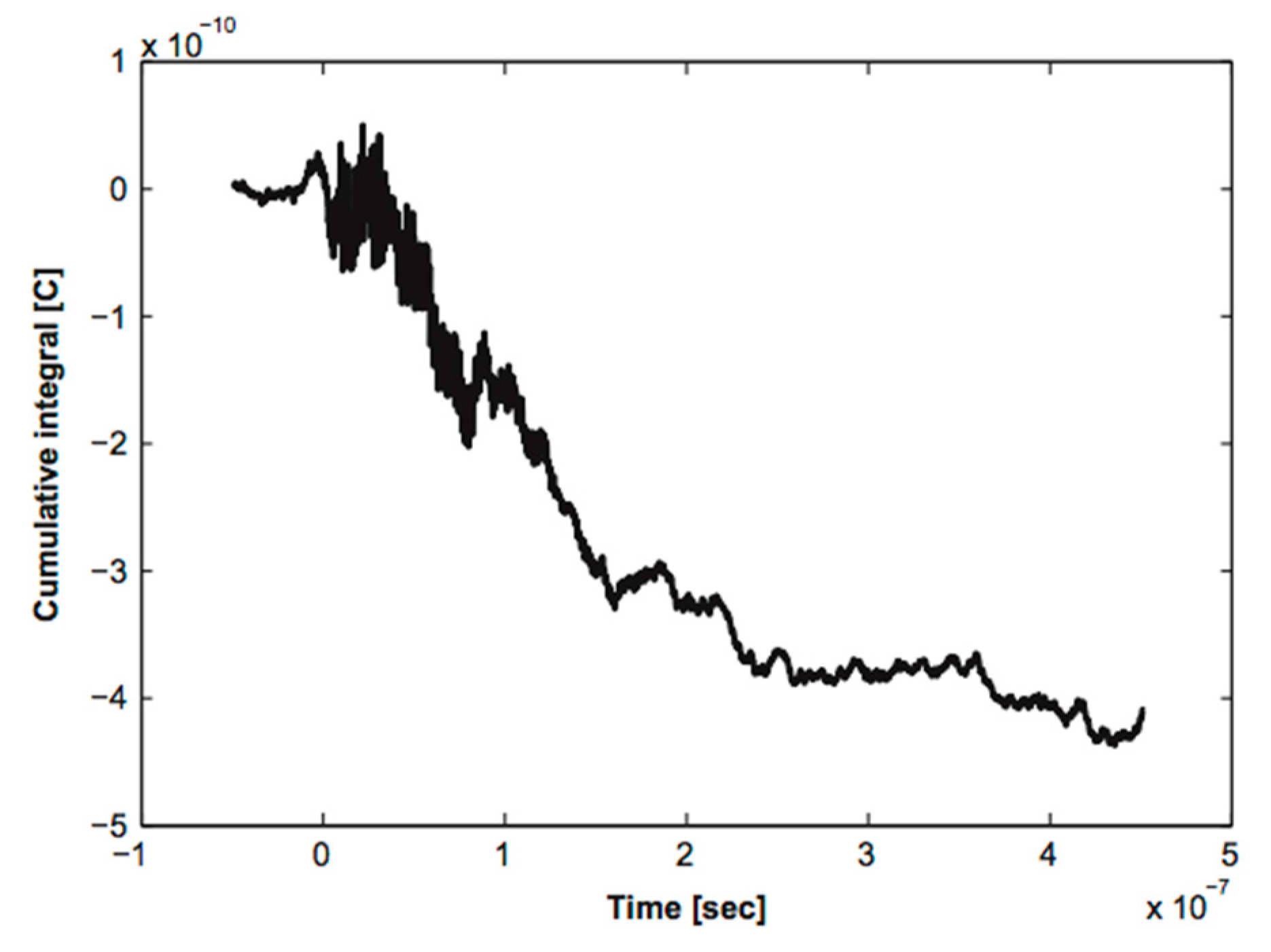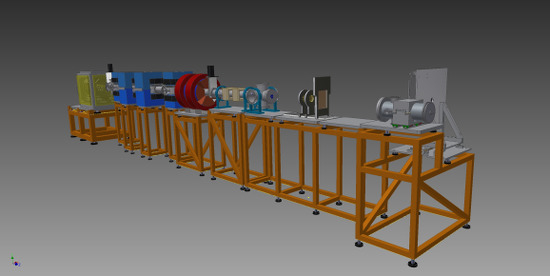3.1. The Focusing System Prototype
The permanent magnet quadrupoles (PMQs) prototype, designed and realized at the INFN-LNSS, consists of two PMQs of 80mm length and two PMQs of 40 mm length with an active bore of 20 mm and 1 mm thick shielding pipe, placed inside the bore for the protection of the magnets. The magnetic field gradient is about 100 T/m [
17]. The system has been designed to improve the transmission and the selection efficiencies of a magnetic energy selector prototype based on four permanent magnet dipoles with alternating field gradient (see
section 3.2 for a detailed description).
The PMQs are based on a hybrid Halbach cylindrical array with eight sectors, as shown in
Figure 1. The poles are set at 45° with respect to the horizontal axis and are attached to four iron sections, almost saturated, used as supporting structure as well as magnetic flux guides. The poles have a rectangular main body (13 × 14 mm
2) with two smaller pieces close to the bore, which allow increases of the field and, hence, the gradient inside the bore itself. The T-like magnets between two poles are modeled as three independent squared pieces (10 × 10 mm
2). The magnetic features of each section of the quadrupole have been evaluated from the BH curve of the materials, NdFeB N50 for the magnets and iron XC10 for the other four parts. Each magnet has its own direction for the permanent magnetization (see red arrows in
Figure 2).
Figure 2.
The layout of the PMQs system prototype based on hybrid Halbach design.
Figure 2.
The layout of the PMQs system prototype based on hybrid Halbach design.
Design based on hybrid Halbach design with standard rectangular magnetic blocks. Field maps are simulated with 0.5 mm step and scaled according to the measurements provided by the SigmaPhi Company (Vannes, France) during the manufacturing process [
17].
The system can be used for focusing and collecting protons up to 30 MeV, although, according to the simulation results, the best performances can be achieved for energies lower than 20 MeV. An example of particle tracing performed using the code for optics calculation TraceWin [
24], in the PMQs system optimized for the 5 MeV proton injections in the energy selector prototype is shown in
Figure 3. The ESS is simulated as a three collimator system in line: collimator 1 and 2, with a 10-mm diameter aperture, are used to remove from the beam particles with large divergence, the slit is a rectangular aperture of 1 × 10 mm and is responsible for the energy selection and the selected energy resolution. The focusing system ensures a transmission efficiency of about 1%–2% for the whole beam line.
Figure 3.
Horizontal envelop (upper panel) and vertical envelop (lower panel) of the beam line for a monochromatic beam (5 MeV) with a spot size of 100 μm and 170 mrad half angle divergence.
Figure 3.
Horizontal envelop (upper panel) and vertical envelop (lower panel) of the beam line for a monochromatic beam (5 MeV) with a spot size of 100 μm and 170 mrad half angle divergence.
The PMQs prototype has been tested with 10 MeV proton beam delivered by the Tandem accelerator at the LNS.
Figure 4 shows the comparison between the 10 MeV proton beam spot distribution predicted by the beam optics simulations and the experimental data taken using Gafchromic film, EBT3 type. As one can see from the comparison, a good agreement between the simulation and the measured spot size has been obtained.
Figure 4.
Comparison between the simulation results and the experimental measurements (inset) for the 10 MeV proton beam spot along the PMQs system.
Figure 4.
Comparison between the simulation results and the experimental measurements (inset) for the 10 MeV proton beam spot along the PMQs system.
A new system, characterized by higher field uniformity and capable of focusing ions with energies up to 60 MeV/n, has been recently designed for the ELIMED section of the ELIMAIA beam line. It will consist of 5 PMQs with the characteristics described in the
Table 1. This is the lowest proton energy of interest for medical applications, for instance, eye melanoma are treated worldwide with 60 MeV proton beams. This is the reason why transport and selection of 60 MeV/n ions represents our first goal in the feasibility studies related to the applications of laser driven ion beams for therapeutic purposes. After few years of operation, different acceleration regimes will be investigated at the ELIMAIA facility reaching higher energies and, hence, extending the studies at least up to 250 MeV, which is the maximum energy used in proton therapy.
Table 1.
The ELIMED PMQs system features.
Table 1.
The ELIMED PMQs system features.
| n° of PMQ | Geometric length | Field gradient | Bore diameter |
|---|
| 1 | 160 mm | 101 T/m | 30 mm |
| 2 | 120 mm | 99 T/m | 30 mm |
| 2 | 80 mm | 94 T/m | 30 mm |
The layout of the PMQs is shown in
Figure 5. It is based on a standard trapezoidal Halbach array surrounded by two external hybrid arrays made of rectangular block and iron. The inner array is mainly responsible for the field quality of the quadrupole, the external arrays are necessary to increase the volume of the permanent magnet material to reach the required field gradient.
Figure 5.
ELIMED PMQs layout.
Figure 5.
ELIMED PMQs layout.
3.2. The Energy Selector System Prototype
A prototype of an energy selector system (ESS), designed and developed at the INFN-LNS a few years go [
25], is based on four permanent magnet dipoles with alternating fields, similar to a bunch compressor chicane [
26]. Each dipole is 88 mm long; the drift space between the central and peripheral dipoles is 85 mm whereas a 10 mm drift distance separates the central dipoles. In such drift space, the particles with different energies are dispersed along the radial plane and a moving slit is used to select ions within a certain energy range.
Figure 6 shows a scheme of the ESS prototype together with the parameters for the calculation of the path length of a proton inside the magnetic chicane, for the calibration equation and for the acceptance of the system.
Figure 6.
Scheme of the ELIMED ESS prototype.
Figure 6.
Scheme of the ELIMED ESS prototype.
The ESS prototype has been successfully calibrated using accelerator-driven proton beams with FWHM energy spread of 0.5% in the energy range between 2.5 and 5 MeV at the Laboratori Nazionali di Legnaro (LNL) in Padova and between 4.5 and 12 MeV at the LNS in Catania.
Figure 7 shows an example of the experimental results of the slit positions as a function of the energy measured in the energy range available at the LNL, along with a comparison with theoretical predictions. Based on the parameters shown in
Figure 6, the equation describing the slit position as a function of the energy can be derived:
where
q,
M0 and
E0 are charge, mass and rest energy of the ion beam, respectively, Δ
x is the slit position, α
i and
Bi are the bending radius and the magnetic field of the first and the second dipoles, respectively. As shown in
Figure 7 (lower panel) the Equation (1) can evaluate the ion energy in a very good agreement with the experimental measurements (upper panel).
The energy resolution of the system can be estimated from the derivative of Equation (1) as shown in Equation (2).
According to the scaling factor, the experimental results indicate that the system can select protons with an energy resolution of about 30% at 30 MeV ensuring a better resolution for lower energies.
The experimental results have also been compared with the GEANT4 predictions showing a rather good agreement and allowing a fine-tuning of the simulation parameters.
The ESS prototype has been also characterized with laser-driven proton beams at the TARANIS laser facility (Queen’s University, Belfast, UK). During the test experiment two energies, 4.5 and 7 MeV, have been selected using the selection system. Energy spreads, fluence, angular divergence, spot sizes of the proton beam coming out from the energy selection system have been measured for both energies selected. Preliminary results show energy spreads of about ±7% and ±8% for 4.5 and 7 MeV, respectively. The measured average fluence is 5 × 106 p/cm2 when a 4.5 MeV proton beam is selected and about 106 p/cm2 in the case of 7 MeV protons. The results of this experiment will be published elsewhere.
Figure 7.
(a) Experimental measurements of the slit position as a function of the energy, using accelerator-driven proton beam in the energy range between 2.5 and 5 MeV and (b) comparison with the calibration Equation (1) of the energy selection system.
Figure 7.
(a) Experimental measurements of the slit position as a function of the energy, using accelerator-driven proton beam in the energy range between 2.5 and 5 MeV and (b) comparison with the calibration Equation (1) of the energy selection system.
The predicted transmission efficiency of the ESS prototype is quite low (few particles out of ten thousands). Nevertheless, the PMQs system coupled to the ESS will allow increased efficiency up to 1%–2% and also selecting beam more precisely since the energy selection is particularly sensitive to the particle divergence. The beam optics simulation of the whole system, composed by the PMQs and ESS prototypes, is shown in
Figure 8.
Figure 8.
The results of the full beam optics simulation for 5 MeV proton selection (black trajectories). Blue traces represent lower energies and green trajectories represent higher energies. A proton beam is transported from the right to left direction.
Figure 8.
The results of the full beam optics simulation for 5 MeV proton selection (black trajectories). Blue traces represent lower energies and green trajectories represent higher energies. A proton beam is transported from the right to left direction.
A new energy selection system dedicated to the ELIMED section of the ELIMAIA beam line will be designed by the end of the year. It will be based on four electromagnets and will allow the selection of proton and carbon beams up to a maximum energy of 60 MeV/n with a maximum energy spread of 30%.
3.3. On-line Beam Diagnostics and Dosimetry
The pulse properties of optically accelerated ion beams differ significantly from those commonly provided by conventional accelerators in pulse duration, peak current and correspondingly pulse dose rate and energy spectrum. Thus, among obvious properties, such as operational stability, the development of innovative techniques for diagnostics and dosimetry represents a crucial step towards multidisciplinary applications of laser-driven beams with the required uncertainty.
Typical laser-driven beam specifications report proton burst duration of the order of 0.1–1 ns, with intensity ranging from 1010 to 1012 p/burst. Therefore, the detectors developed for the on-line beam monitoring systems and for the relative dosimetry have to be dose-rate independent, in order to be able to measure very intense and short pulses without saturation effects and suitable to operate in presence of a strong electromagnetic pulse (EMP). Different alternative approaches will be followed in the development of detectors for on-line non-invasive beam current monitoring.
Different diagnostics detectors will be placed, in particular, after the focusing and the selection systems. A detector, based on the well-known pepper pot method, will be specifically designed and optimized for single shot emittance measurement of the laser-driven proton beam after the PMQs system. On the other hand, particle identification and fluence/current measurements will be performed using Silicon Carbide (SiC), CVD diamond detectors and secondary particle emission detectors (SEM), based on the secondary electron emission from a thin metallic foil hit by ion beams. These radiation-hard detectors, suitable to work in harsh radiation environments, will be used in ToF mode for plasma ion intensity and energy distribution measurements in the energy range between few MeV/n up to 60 MeV/n. They will be placed at different distances from the target along the beam-line, in particular, after the PMQs system and after the energy selection device at the end of the in-vacuum section of the beam-line. The high temporal resolution and the fast response of SiC and CVD detectors, together with the high signal-to-noise ratio characteristics, already tested in the previous experimental campaign at PALS and at TARANIS laser facilities, will allow determining the energy of the identified selected ions with resolution of about 20% for the maximum energy selected (i.e. 60 MeV/n).
So far, no protocol for absolute dosimetry for optically accelerated ion beams has been established. In order to fulfill this task, a reliable and accurate dosimetric characterization of laser-driven charged particle beams has to be performed. Therefore, devices and procedures to develop a calibration method for absolute dose evaluation have to be implemented.
The device proposed to perform absolute dose measurements will consist of a Faraday Cup (FC) specifically designed to measure the beam charge with high accuracy and extract the absolute dose for pulsed laser-driven beams. Indeed, thanks to the linear response with respect to the beam intensity and the dose rate independent signal, a FC is expected to allow charge collection with high level of accuracy, also in case of high pulsed and extremely intense beams.
A FC prototype [
27] for absolute dosimetry with high-pulsed ion beams has been recently designed and realized at the INFN-LNS within the ELIMED project. The FC technical design has been inspired to similar detectors already developed for ion-beam dosimetry [
22,
28], adopting innovative geometrical solutions in order to further improve the overall charge collection efficiency [
29].
In the absolute dose measurement using a FC, the main uncertainty sources are related to the precise measurements of the total charge carried by the beam, of the proton beam energy spectrum and of the effective beam area, needed to extract the fluence distribution. Each of these quantities has to be separately and accurately evaluated. An issue related to the total charge measurements is represented by the emission of secondary particles, usually electrons, produced by the interaction of the protons with the entrance foil and the cup material itself. The emitted secondary electrons may be either collected or leave the cup, affecting the collected charge measurements. The secondary electrons produced in the vacuum window former may lead to a total charge underestimation, while those produced within the cup material, if produced with sufficient energy, may leave the collecting cup and cause a charge overestimation. In order to maximize the charge collection measurement accuracy by increasing the probability of capturing the secondary electrons emitted, shape, sizes, materials and electric field characteristics have been modeled and determined, with the help of the GEANT4 MC simulations and electrostatic ion trajectory software, such as the COMSOL FEM (Finite Element Method) [
30] and the Simion FEA (Finite Element Analyse). These studies aimed to increase the efficiency and reliability of the FC design as a charged particle current detector.
Figure 9 shows the final FC prototype configuration with all the geometrical details. The FC prototype technical details and the simulation results on the electric field generated can be found in ref. [
27].
Figure 9.
Technical drawing of the FC prototype realized at the INFN-LNS.
Figure 9.
Technical drawing of the FC prototype realized at the INFN-LNS.
Typical FC detectors have cylindrically symmetric components and employ coaxial electrostatic fields to recapture the ejected electrons. In the FC prototype, the electric field results by the combined effect of two coaxial electrodes. The external electrode is a metallic hollow cylinder and the internal one, follows a similar design presented by Thomas
et al. [
29], is a peculiar beveled cylinder. The addition of this element breaks the electrostatic coaxial symmetry of the field, provided solely by the external electrode, by introducing a relevant transverse electric field component, as it can be seen in
Figure 10, which allows recapturing secondary electrons improving the deflection of the secondary electrons emitted by both the entrance window and the cup.
In order to investigate the FC prototype response, an experimental campaign has been performed using the 62 MeV proton beams delivered by the superconducting cyclotron (CS) at the CATANA protontherapy facility [
31] at the INFN-LNS (Catania, Italy). A complete characterization of the FC prototype charge measurement varying the bias applied to the suppression electrodes, the proton beam incident current and the dose delivered has been also performed. The FC prototype has been placed about 9 cm downstream from the final collimator along the beam-line, a 20 mm diameter collimator has been used for the measurements. The FC operating vacuum was 10
−5 mbar. The FC current signal as a function of the collecting time was measured using of the electrometer Keithley 6517A.
In order to compare the secondary electron suppression efficiency using the external electrode alone and the two coaxial electrodes together, the characterization of the FC prototype charge collection as a function of the applied voltage has been performed using both configurations. The voltage has been varied from −4000 Volt to 4000 Volt. Each charge measurement has been performed delivering a given dose of 15 Gy. The dose released has been monitored using the online transmission ionizations chambers.
Figure 11 shows some preliminary results of the collected charge as a function of the applied voltage. Each charge measurement has been obtained integrating the current signal for the time interval required to deliver 15 Gy.
Figure 10.
Transversal, longitudinal and radial components of the FC prototype electric field as a function of the FC longitudinal size, obtained using the COMSOL software (COMSOL, Brescia, Italy).
Figure 10.
Transversal, longitudinal and radial components of the FC prototype electric field as a function of the FC longitudinal size, obtained using the COMSOL software (COMSOL, Brescia, Italy).
Figure 11.
Charge collected by the FC prototype as a function of the bias applied to the external electrode.
Figure 11.
Charge collected by the FC prototype as a function of the bias applied to the external electrode.
As one can see, a typical flat voltage response plateau in the negative voltage range between −2400 V and −400 V can be observed; on the other hand, for positive voltages a collected charge dependence increasing with the voltage applied is evident. The charge collection response observed in the FC prototype is in agreement with the typical behavior of standard FCs used for absolutedosimetry [
22,
28]. The analysis of the charge measurement data using the internal beveled electrode is still on going. Nevertheless, based on a preliminary comparison the electric field resulting from the two coaxial electrodes improves the electron suppression efficiency.
Recently, characterizations of the electromagnetic pulse (EMP) effect on the FC prototype signal has been carried out at the PALS laser facility, in Prague (Czech Republic) and at the TARANIS laser facility at the Queen’s University in Belfast (UK). Typically, a high power laser-matter interaction and the subsequent plasma production are accompanied by the emission of an intense EMP, which propagates inside and outside the interaction chamber [
32] interfering with the diagnostic devices and affecting their response. Therefore, particularly for a dosimeter, it is crucial to perform a systematic study, in terms of frequencies and amplitude of the EMP generated by the laser pulse, to perform accurate dose evaluations. Indeed, the EMP produces a not-negligible background signal that, if not carefully characterized, does not allow a precise charge measurement [
32].
The FC prototype has been tested by using a laser-driven proton beam during an experiment [
27] performed at the PALS laboratory (Prague, Czech Republic), where a 2 TW laser system (about 1 KJ of energy delivered on target and a time duration of 300 ps) is available. The FC was mounted inside the experimental hall at approximately 2 and 5 m from the interaction chamber for a characterization of the EMP propagating outside of the chamber and directly connected to the interaction chamber at 30° in the backward direction with respect to the target normal axis. The FC signal was registered with a 2 GHz Le Croy Digital Oscilloscope.
Figure 12 shows a typical FC signal registered during the experiment.
Figure 12.
A FC signal registered during the PALS experiment. The inset shows the Fast Fourier transformation of the signal.
Figure 12.
A FC signal registered during the PALS experiment. The inset shows the Fast Fourier transformation of the signal.
As one can see from the inset in
Figure 12, the EMP is characterized by frequency components from few hundreds of MHz up to 2 GHz. Based on the frequency analysis, the significant noise signal results from the EMP propagation inside the interaction chamber [
33,
34] and seems to be predominant with respect to the charge signal, affecting the measurement of the total collected charge. Nevertheless, the cumulative integration of the FC signal, as shown in
Figure 13, reveals the presence of a charge contribution that, although very small, can be separated by the huge EMP noise contribution [
27]. Indeed, even though the EMP signal is present, a null final cumulative value is expected due to their identical positive and negative contributions to the integral. On the other hand, for those signals registered when the FC is mounted on the interaction chamber (
i.e. along the plasma emission direction) a signal generated by the incoming charged particles accelerated from the target is expected to be present together with the typical EMP contribution. Therefore, as it can be observed in
Figure 13, the cumulative of those signals deviates from a null final integral showing a decreasing-negative trend, which indicates a continuous negative contribution to the integrated signal.
This result indicates the necessity to perform a thorough study to allow the separation of the noise contribution from the physical signal. The use of appropriate electronic circuits, as filter amplifiers, and also proper EMP shielding will allow removing or reducing the higher frequency contributions related to the EMP.
The analysis of the data taken during the experimental campaign performed at the TARANIS laser facility at the Queen’s University in Belfast (UK) is currently on going and the results will be published elsewhere.
Figure 13.
The cumulative integration of the FC signal.
Figure 13.
The cumulative integration of the FC signal.

